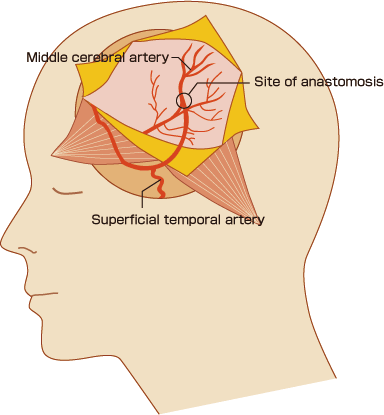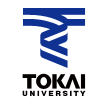- HOME
- For Patients
- Moyamoya disease
- Treatment of moyamoya disease
Moyamoya disease
- About moyamoya disease
- Symptom of moyamoya disease
- Diagnosis of moyamoya disease
- Treatment of moyamoya disease
Treatment of moyamoya disease
Some medications to improve blood flow may be used as drug treatments, but have no effect in improving symptoms or preventing hemorrhage.
Hemorrhage requires emergency treatment, and surgery is performed to remove the blood from inside the brain. No effective treatment is capable of directly opening the blocked large blood vessels. A method called "revascularization" is widely used to further supplement the flow of blood in order to prevent blood flow in the "puff of smoke" vessels that compensate for the blockage from decreasing and causing sudden ischemic symptoms. Good blood flow is still maintained underneath the skin on the outside of the skull, even if blood flow to the brain has decreased. The most common revascularization procedure is to join the superficial temporal artery, which runs beneath the skin, to the middle cerebral artery on the surface of the brain by means of an anastomosis (vascular connection) (Figure 1). Another operation is to transplant the superficial temporal artery to the surface of the brain together with its surrounding tissue, which has abundant blood flow. Yet another option uses the temporal muscle from the surface of the skull to cover the surface of the brain. Moyamoya disease reduces blood flow to both sides of the brain, so each side is treated separately with an interval of several months between treatments.
[ Fig 1 : Anastomosis ]

Treatment Outcomes
Japan has a long history of the diagnosis and treatment of moyamoya disease. This means that moyamoya disease in children is known to show good prognosis if an appropriate anastomosis is performed.
In young children with rapidly progressing symptoms, however, moyamoya disease may cause persistent neurological and cognitive impairment.
In adult-type moyamoya disease, in which hemorrhage frequently occurs, severe aftereffects may remain, depending on the amount and location of hemorrhage. In the case of major hemorrhage, a high risk of death may sometimes be seen. Compared with the ischemic type, the hemorrhagic type has the following problems:
- more severe symptoms;
- an 18-40% risk of recurrent hemorrhage, which not infrequently occurs even 10-20 years later; and
- a lack of effective methods of treatment for preventing hemorrhage.







